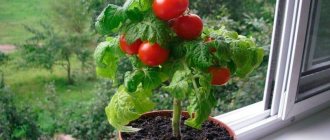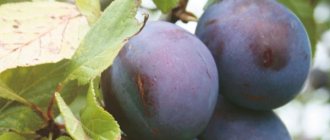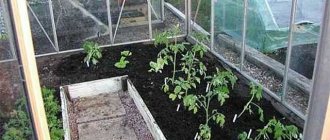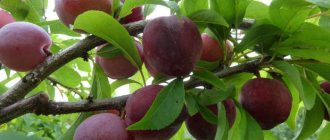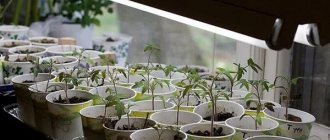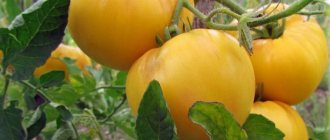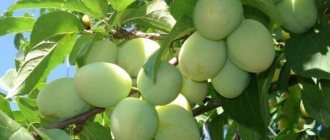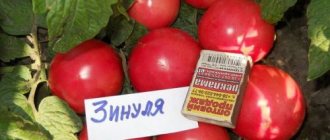Characteristics and descriptions of sugar plum tomato varieties
The variety “Yellow Sugar Plum” was bred by Russian breeders.
Included in the State Register of the Russian Federation in 2008. Purpose – cultivation in open ground and in greenhouse conditions. The “Red Sugar Plum” tomato was included in the State Register in 2009. The plant was bred by Altai breeders. Tomatoes grow in fields, gardens and protected ground.
The varietal tomato “Sweet plum raspberry” was bred by Russian breeders. Not included in the State Register of the Russian Federation. The variety is intended for cultivation in greenhouses and under film, but can also grow in open ground.
Early (95-105 days from germination to ripening), semi-determinate, medium-sized, productive tomato variety. Recommended for growing in greenhouses and open ground with a garter to a support.
Bush 1.2-1.4 meters high. The best result was obtained when forming a plant with 2 or 3 stems.
In some catalogs this variety is called Red Sugar Plum.
The fruits are elongated-plum-shaped, smooth, red in color at maturity, weighing 30-50 grams, good (for early) taste. These tomatoes seem to be created for whole-fruit canning - their shape, size and consistency are ideal for this.
Tomato yield Sugar plum: up to 3 kg of fruit from 1 plant (subject to agricultural practices).
Advantages of the variety: resistance to fruit cracking, high taste and technological qualities.
There are 4 varieties in total: red, crimson, orange and yellow:
- The Yellow Plum tomato was added to the register in 2008. Fruits appear approximately 87-95 days of germination. Color is acquired during the growth process. Rich in microelements and vitamins.
- The sunniest is the Orange plum tomato; the characteristics and description of the variety say that it belongs to the mid-season, the fruits ripen in 110-115 days. It is considered compact, and the fruits can be stored for up to 60 days.
- The raspberry variety is still not included in the register. It is practically no different from the yellow species in terms of characteristics.
- The red variety of tomatoes was officially listed in 2009. The variety was bred in Altai and can be grown both in greenhouse conditions and outdoors. The first fruits are born on days 106-110.
Tomato Sugar plum
You can often hear about the black plum tomato. It is quite demanding in terms of conditions and can only be grown in specially prepared soil.
Description of the delicious Black Plum tomato and cultivation techniques
- Plant characteristics
- Description of fruits
- Agricultural technology varieties
Fans of unusual vegetables will love the Black Plum tomato. The variety appeared in the Urals and is adapted to unfavorable conditions and short summers. Tomatoes can be grown in greenhouses and open ground.
Plant characteristics
The Black Plum tomato bush is distinguished by its tallness: even in open ground it reaches 1.8 m, and in a greenhouse its height can be even greater. 6-8 clusters with fruits are formed on the bush. The formation of ovaries occurs throughout the summer. When cultivating in open beds, it is recommended to pinch tomato bushes, stopping the growth of the stems approximately in the 2-3rd decade of August.
The Black Plum variety is a mid-early tomato. The first tomatoes ripen 90-100 days after emergence. But the massive yield of the crop occurs after 1 week and continues until the end of the season.
The tomato yield reaches 3.5-4 kg per bush. With the recommended planting pattern of 30x50 cm per 1 m², it is possible to place only 3 bushes. A tall and well-branched plant requires obligatory tying to a support and pinching. It is better to form bushes with 2 stems, this slightly increases the yield and does not thicken the plantings too much.
The Black Plum tomato is resistant to late blight and other fungal diseases. In case of sudden temperature changes or unfavorable weather conditions, the yield of the variety practically does not decrease. The description of the properties of tomatoes given by experienced gardeners notes a slight decrease in taste and the appearance of sourness in fruits that grew in open ground in cold summers.
Description of fruits
Fruit clusters are complex and branched. On each of them 7-12 dark red, almost black fruits are formed. The size of the ovaries on 1 brush is almost the same. The average weight of the fruit is 50-60 g; tomatoes rarely reach a weight of 70 g.
The shape of the fruit is plum-shaped, without ribbing or protrusion at the apex. Black Plum tomatoes can be classified as bicolors, since the dark spot at the base gradually loses color intensity, turning into a dark purple hue at the top of the fruit. Unripe tomatoes are pale green with a dark spot near the stem.
The skin is dense and, given the small size of the fruit, protects it well from damage during transportation. Such tomatoes can be stored for a long time without losing their taste. They also ripen well indoors if they are collected in the milky or blanzhesky phase of ripeness.
Small tomatoes are well suited for whole-fruit canning. The decorative value of blanks with dark tomatoes will be very high. Tomatoes do not burst and retain the density and texture of the pulp even when salted or pickled.
Black plum tomatoes can be used to prepare very tasty and beautiful tomato sauces and rich red juice. These preparations have a sweet taste, and the sauces are well suited for Italian dishes. But the best way to prepare such tomatoes is drying.
The dark, beautiful fruits can also be eaten fresh. Children especially like them because they are the first to appear on the table. Salads with Black Plum tomatoes look elegant and picturesque. You can make beautiful snacks from dark-fruited tomatoes, stuff them with different fillings or use them in vegetable cuts.
Agricultural technology varieties
Growing dark tomatoes is no different from caring for simple red varieties. But when planting, you should take into account some nuances characteristic of this particular variety:
- When choosing a place for planting, preference should be given to the sunniest and well-warmed place in the garden. This will make the fruits especially sweet and aromatic.
- You need to sow seeds 1.5-2 months before planting in the beds.
- During the season it is necessary to feed the plants 3 times. You need to use special mineral mixtures (Signor Tomato, Crystalon and others). Fertilizing is carried out 1-2 weeks after planting, and then repeated after 2 weeks.
- Tomatoes should be watered sparingly. If there is no natural precipitation, watering is done once every 5-7 days. Excessive moisture can make black plums less tasty.
- Tomatoes ripen very quickly, so you can pick them together with a twig, cutting it off at the base. This way, unripe fruits can ripen faster, and already ripe ones can last longer.
This unpretentious variety of tomatoes will definitely thank the owner for good care. But even with a lack of attention, the bush will produce fruits that are good in consumer qualities.
Description of the variety and its varieties
The first of the Sugar Plum series was the red tomato, which appeared in 2007. A little later, SeDeK released yellow and crimson varieties to the market. The striped one appeared in 2021. It is radically different from the other three (fruit size, bush height, ripening time, etc.), and therefore deserves a separate analysis. In this material we will talk about older varieties.
Tomatoes are oriented to protected soil. They can be grown in any region of the Russian Federation suitable for agriculture. None of the subspecies of the crop has a certificate from the State Varietation Commission. But the seeds comply with GOST.
The bush is medium-sized, densely covered with medium-sized leaves. The fruits on one plant are aligned and ripen together. They are collected in complex fan brushes of 4-7 pieces. The pulp is dense and juicy. The skin is durable. Tomatoes of different varieties from this group practically do not differ from each other in shape and other characteristics (only in color).
According to ripening time | By type of growth | By type of use | By growing method | Fruit weight (g) | Productivity (kg/m2) | Fetal characteristics |
| Early ripe (87-95 days) | Semi-determinate (1.2-1.4 m) | Universal | For greenhouses and greenhouses | 20-25 | 9-10 | Red, crimson or bright yellow, plum-shaped, smooth, dense |
Cream tomato: characteristics of the variety
A plum tomato is not a specific variety of tomato, it is a whole group of tomato varieties of various shapes and shades. They are suitable for long-term transportation and further resale. In addition, this group of varieties is characterized by increased productivity, which makes it popular among farmers.
Description of the variety
Initially, cream tomatoes were intended exclusively for canning and use in making sauces. Now this group includes tomatoes of different shapes and sizes, and their “calling card” is increased productivity.
Cream tomato has a thick skin
The characteristics of the plants are as follows:
- tomatoes weighing from 60 to 300 g, thick skin and increased meatiness. There are few seeds in the fruits, they have low juiciness, so they are not always suitable for fresh consumption;
- retain their shape well during transportation;
- fruit ripening and harvesting occur only once per season;
- from 1 sq. m of growing area, you can harvest up to 10 kg of tomatoes;
- there is the possibility of growing in greenhouses;
- resistance to adverse conditions and pests;
- any color of fruit - from red and pink to yellow and black.
Cream is grown all year round and can be found on the shelves of shops and markets every day.
The most popular varieties
Since there are many tomatoes in this group, let’s consider the most hardy and popular varieties:
- Gigant is a mid-season variety with large, rich red fruits. It has a sweet taste and dense flesh.
- Orange is a mid-season variety characterized by increased productivity. It has orange fruits and is resistant to temperature changes;
- Aquarelle is an early-ripening variety with bright red fruits. It is characterized by increased resistance to diseases and pests;
- De Barao is a late variety of tomatoes that has very powerful bushes and the same fruits. Features a variety of colors. There are red, orange, black, and yellow. The fruits are smooth and small, weighing about 80 g;
- Large cream is the brightest and most characteristic representative of the group of varieties. It is absolutely unpretentious in care, has oval, pointed fruits of an orangeish hue. The pulp is sweet and soft. The variety is easily transported and stored for a long time.
The cream tomato group is grown mainly in large quantities for sale. Tomatoes are undemanding in care, are well stored and transported, and also have excellent taste.
qwertyiil
Advantages and disadvantages of the variety
The main advantages of “Sugar plum” tomatoes:
- Beautiful fruits;
- Early ripening;
- Excellent taste;
- The fruits can be stored for up to two months;
- Excellent presentation;
- Tomatoes withstand long-term transportation well;
- Tomatoes contain a large amount of useful substances.
The review variety also has some disadvantages:
- The plant is not resistant to diseases and pests;
- Seedlings need to be pinched;
- Each bush needs to be tied to a separate support.
Growing the Sweet Plum variety requires compliance with certain rules and recommendations.
Before sowing the seeds, you need to sort them out, removing all damaged seeds. Selected planting material should be disinfected in a solution of potassium permanganate. To do this, the seeds are placed in a weak solution of manganese for 10-12 hours. After the specified time, it is recommended to dry the seed thoroughly.
Before planting seeds, care must be taken to prepare the soil. Ordinary soil will not work; you will need to either purchase special soil in a store or make it yourself. To do this, mix peat, sand, soil and turf. These components are mixed and a little sifted ash is added.
The container with future seedlings should be placed in a warm and bright place, preferably on a windowsill or on a closed balcony.
Once the plants have two permanent leaves, they can be placed in separate pots or containers. For proper development, seedlings require frequent watering with warm, settled water and regular fertilizing with organic and mineral fertilizers. By mid-May, 6-7 leaves appear on the seedlings, which means they can be transferred to the greenhouse.
Tomatoes can only be planted in open ground by mid-June. A week before planting in unprotected soil, seedlings should be hardened off. It is recommended to take containers with seedlings out into the fresh air for a short time.
The best place for seedlings will be an area where greens, carrots, zucchini, and cucumbers previously grew.
- By planting all three varieties of the variety, you can close the stunning assortment for the winter.
- Subject to transportation.
- Long-term storage up to 60 days is possible.
- Excellent presentation.
- Great tomato taste.
- Versatile. Can be used for fresh consumption, added to various dishes, and canned for the winter.
- Early harvest.
- Contain a large number of useful substances.
Tomatoes are grown in private farms, on small farms and large agricultural firms.
Farmers note the following advantages of Sugar plum tomatoes:
- Exquisite taste that almost everyone likes. The fruits are rich in nutrients, minerals and vitamins.
- Attractive appearance. Small and neat fruits look beautiful and appetizing.
- The ability to create an original assortment of red, yellow and crimson berries.
- Versatility in terms of culinary use. Tomatoes are eaten fresh, processed and canned.
- Good keeping quality of ripe fruits. This property is used for long-term storage and transportation of tomatoes to areas where there is increased demand for them.
- Early and friendly maturation. If you follow the rules of sowing and caring for plants, the first tomatoes appear abundantly and densely on the bushes already in early June.
The variety also has its drawbacks. The main one is low immunity to infectious and fungal diseases. Cultivating tomatoes requires tying up the stems and regularly removing shoots. Tomatoes are sensitive to soil moisture and acidity. Watering and application of mineral fertilizers should be done in doses.
Features of the variety
Among the main advantages are the following:
- If you plant several varieties of plum tomatoes in one season, you can get a real assortment of shades.
- They can be transported.
- Ability to store ripe fruits for up to 60 days.
- They have an excellent presentation.
- They have excellent taste.
- They can simply be eaten or added to canned tomatoes.
- The harvest will be early.
- High yields.
- Contains many useful substances.
So, the Plum tomato will find use among gardeners who need an early harvest of medium-sized fruits.
Tomatoes: advantages, disadvantages and taste
The main advantages of “Sugar plum” tomatoes:
- Beautiful fruits;
- Early ripening;
- Excellent taste;
- The fruits can be stored for up to two months;
- Excellent presentation;
- Tomatoes withstand long-term transportation well;
- Tomatoes contain a large amount of useful substances.
The review variety also has some disadvantages:
- The plant is not resistant to diseases and pests;
- Seedlings need to be pinched;
- Each bush needs to be tied to a separate support.
Advantages and disadvantages, use in cooking
Pros:
- commercial qualities;
- excellent taste;
- unpretentiousness;
- weather resistance.
Minuses:
- insufficiently strong immunity.
You can evaluate the combination of multi-colored Sugar Plum tomatoes from the photo. Assorted whole fruits in a jar - beautiful and tasty. Breeders also recommend harvesting red fruits in their own juice. All varieties in the series are also suitable for fresh salads.
List of other positive qualities of tomato:
- Great taste. Summer residents describe it as sweet and pleasant, especially in the yellow variety.
- Good indicators of crop safety. It does not crack on the branches during ripening, is normally stored in a shaded room in a ripe state, and is transported without damage. This applies to a greater extent to yellow-fruited “cream”.
- Decent fruit quality. The share of commercial harvest tends to 100%.
- Increased benefit. The fruits contain a lot of vitamins and sugars.
- Evenness and synchronous ripening of the crop on one plant.
Disadvantages of tomato:
- mediocre yield per 1 sq. m;
- the need for regular cleaning from stepchildren;
- need for support.
Fruit characteristics
Similar to Yellow Sugar Plum. Contains the following information:
- the size of a ripe tomato is smaller than average;
- inside there are 2 nests with seeds;
- plum shape;
- sweetish taste.
Tomatoes contain vitamins and sugar that are beneficial for the body. Fruits of the same size are used for whole-fruit canning. They look beautiful in a jar and do not crack. They have thin skin.
Features of plant agricultural technology, reviews from gardeners
The procedure for growing tomatoes is simple. It is more effective to use the seedling method. Sowing is carried out 55-60 days before transferring young bushes to the garden. It is important to have 4-5 leaves and at least one flowering brush. In a greenhouse, sprouts are usually rooted in mid-May, in an open-air garden bed - in the first days of June.
Advice. Plant no more than 3 tomatoes per 1 square of land. Scheme: 40x70 cm. Form plants into 2-3 trunks.
There are a lot of reviews on the Internet about the Sugar Plum tomato. The yellow-fruited variety is especially discussed by gardeners. Nadezhda from Orenburg tells a story about the experience of several seasons of planting raspberry “cream”. The fruits turned out small and burst on the branches. The woman liked the yellow analogue much more in taste and product quality. Yulia (Samara region), who used the harvest for winter harvesting, also agrees with her.
A summer resident with the nickname Edelis1 also successfully grew and sealed this tomato in jars. The variety pleased everyone. Overall there are a lot of positive reviews about this series. Despite the lack of certification, the tomato is quite in demand among the people.
Advantages of varieties
Both varieties are suitable for canning tomatoes for the winter. Thanks to the different colors, you can make an interesting assortment for the winter. Among the advantages of both types are:
- long distance transportation (for sale);
- storage in plucked form for 2 months;
- beautiful appearance;
- sweetish taste with sour notes;
- versatility of use.
The plant begins to bear fruit early, so fresh tomatoes will delight your family and friends. Can be added to food fresh. Suitable for preparing salads and sauces. The aroma saturates the dish with lightness and piquancy at the same time.
Features of cultivation, planting and care
Seeds are planted in the second decade of March. After disinfection, they are immersed in the ground to a depth of 1-1.2 cm. With a small number of seeds, peat tablets can be used. If there are a lot of grains, then it is better to use flowerpots filled with fertile soil with expanded clay drainage. The containers are covered with film and placed in a warm room.
Emerging seedlings need warmth and plenty of light. It is advisable to place the flowerpots on the windowsill. If there is a lack of natural light, it is compensated with fluorescent lamps. A constant temperature of 22… 23ºС should be maintained. After the first 2 leaves appear, the seedlings are planted. A week before transplanting into the beds, the plants begin to harden off, gradually lowering the air temperature and increasing the time spent outside. Transplantation is carried out when 5-7 leaves appear on the stems.
Preparation of beds includes adding drainage, ash, charcoal, calcined sand and fertilizers to the soil. It is recommended to spill an insecticide solution around the holes to protect the plant roots from parasites. 8-9 plants are planted per 1 m² of bed. They are immediately attached to pegs or tied to a trellis. As the stem grows, this procedure is repeated.
Feeding must be done monthly. During the formation of the stem and crown, it is advisable to use ammonium nitrate and magnesium sulfate. After the ovary appears, a solution of mullein or bird droppings is added to the soil. Caring for plants involves weeding, mulching the soil, collecting parasites and periodically spraying with disinfectant solutions.
In order to protect bushes from fungal diseases, you must follow these rules:
- do not plant seedlings too densely;
- provide sufficient lighting;
- avoid oversaturation of the soil with fertilizers;
- provide moderate watering and high-quality ventilation.
It is important to remember that if signs of disease are noticed on one plant, it should be replanted so as not to expose the rest of the bushes to infection.
We recommend sowing seeds for seedlings 55-60 days before the intended planting in the ground. Seedlings dive at the stage of two true leaves. When planting seedlings in a permanent place per 1 sq. It is recommended to place up to 3 plants per meter of land.
Further care for tomatoes consists of timely watering, fertilizing with complex mineral fertilizer, pinching and preventive measures to protect against diseases and pests.
If you grew Sugar Plum tomatoes, please write whether you liked them or not. What was the yield and taste of the fruits in your climatic conditions? Will you be growing them again? Briefly describe the advantages and disadvantages (pros and cons) of this tomato in your opinion. If possible, attach a photo of the entire bush or individual fruits you grew to your comment. Thank you!
Your reviews of the Sugar Plum tomato and additions to the description will help many gardeners evaluate this variety more objectively and decide whether it is worth planting or not.
This is a natural variety of tomato. Therefore, we recommend taking seeds from a ripe fruit and growing them again next season!
Growing seedlings
Depending on the growing method, sowing seeds for seedlings is carried out at different times:
- for transplanting into a greenhouse - at the end of February or beginning of March;
- when planting tomatoes in the garden - in the second half of March and early April.
Seed preparation
You can purchase seeds of this variety at any gardening store. Buy quality material that has not expired.
Before sowing, the seeds need to be discarded, which will increase the percentage of their germination. They are poured into any deep container and filled with saline solution (1 teaspoon of salt per 1 liter of water). After half an hour of soaking, the bad seeds will float to the surface, and the good ones will sink to the bottom. They are removed, washed under water, then dipped in a raspberry solution of potassium permanganate.
The disinfection procedure lasts 30 minutes. Then the seeds are washed again and sprayed with a solution of a growth stimulator (Epin, Zircon).
The last procedure: the seeds are kept in a damp cloth for 48 hours. During this time they will swell and hatch. To avoid drying out, they need to be placed in a cool and shaded place and sprayed several times.
Preparing the container
The main requirements for seedling containers are a height of at least 10 cm and the presence of drainage holes.
You can use a wooden box, a plastic container or disposable containers (200 ml plastic cups, peat pots). When grown in a disposable container, there is no need to plant the sprouts, which eliminates the risk of injury.
Priming
According to the description, tomatoes of the Ivanych variety grow well in light, loose, fertile and slightly acidic soil. A purchased substrate for growing vegetable seedlings will be optimal. You can also use homemade soil mixture. To do this you need to mix several ingredients:
- garden soil;
- rotted manure;
- coarse sand;
- wood ash.
Proportions – 2:1:1:1.
For cultivation you need to prepare fertile soil
Instead of sand, some use sawdust from fruit trees. If the soil is too acidic, it is worth adding a handful of dolomite flour, chalk or slaked lime.
Before planting, the soil is calcined in the oven or watered with boiling water/raspberry solution of potassium permanganate.
Technology
The planting container is filled with soil mixture and compacted, retreating 2-3 cm from the top. When sowing in groups, make furrows at a distance of 4-5 cm from each other, then lay out the seeds, keeping a distance of 3-4 cm between them.
When sowing in cassettes, disposable cups or peat pots, make indentations. Place 1-2 seeds in each. The optimal sowing depth is 1 cm. If you sow the seeds deeper, they will take longer to germinate, and some of them may not hatch at all.
The crops are sprinkled with a thin layer of a mixture of sand and earth, then irrigated with a spray bottle and covered with transparent glass or film.
Growing conditions
For good germination of crops, optimal conditions must be provided:
- stable temperature within 25-26 °C;
- humidity about 60%;
- diffused daylight for 4 hours a day;
- to avoid the formation of condensation inside the greenhouse, seedlings must be ventilated periodically (every day for 30 minutes);
- remove weeds;
- Irrigate with warm water as the soil dries.
If these conditions are met, in a week you can expect a massive emergence of seedlings, after which you need to immediately remove the shelter and move the crops to a cool but well-lit place. The seedlings are kept there for 5 days so that they grow the root system and do not stretch out, and then they are returned to their original place.
At the stage of appearance of the first two true leaves, picking is carried out. The crops are watered with water, an hour later the seedlings are removed and, together with a clod of earth, planted in disposable cups. The lack of soil is made up for with a mixture of humus and garden soil (1:1).
In order for the seedlings to take root better in a new place, they should be sprayed with a solution of urea or nitrophoska - 15 g per 10 liters of water. 20-30 ml of working solution is poured under each plant.
Best reviews from our readers
- Galina
I have been planting this variety for 4 years now, I am very pleased. The bush is about 2 meters, the harvest is always high, regardless of the year. Good for preservation.
Approximately 2-3 times per season the bushes need to be tied to a support or trellis. The stem of the plant is formed into 2 or 3 stems, leaving 2 stepsons just in case, in reserve.
“Sweet plum” tomatoes are compact. For 1 sq. You can plant up to 9 plants per meter.
Tomatoes should be watered at least twice a week and the beds should not be allowed to dry out.
After 14 days after transplanting young plants, fertilizing can be applied to the soil. Gardeners advise using magnesium sulfate or ammonium nitrate.
During the formation of ovaries on tomatoes, it is necessary to add a solution of bird droppings or mullein to the soil.
Treatment of seedlings with a solution of boric acid or the preparations Tomaton and Ovary stimulates flowering.
Seeds are sown in mid-March, having previously been disinfected in manganese. Soil from the garden is not suitable for seedlings, you can either purchase it in a store or make it yourself, for this you will need sand, peat, a small amount of ash, turf soil and soil, all of this, except the ash, take in equal quantities and mix.
After the plants produce two leaves, they can be transplanted into separate containers. For its proper development, fertilizing and regular watering with warm water are necessary. Towards mid-May, 6-7 leaves already appear on young plants, which means that they are ready to be transplanted into the greenhouse.
“Sugar plum” can be transferred to open soil only in June. 7 days before this, it is recommended to harden the seedlings by taking them out into the fresh air for a short time. The best predecessors for tomatoes are: carrots, cucumbers, herbs and zucchini. Before planting, the soil must be fertilized using any organic fertilizer.
Bushes need to be tied to stakes or a trellis, about 2-3 times per season. The stem is formed into 2 or 3 stems, leaving 1-2 stepsons in reserve. The variety is distinguished by compact bushes; up to nine pieces can fit on one square meter. It is necessary to water at least twice a week and do not allow the soil to dry out.
Soil and fertilizing
Like other early-ripening tomatoes, this variety is very demanding on the composition of the soil and timely fertilizing.
Important!
You cannot plant any nightshades in one place for more than two years in a row. The soil is depleted and diseases and pests of this plant family appear. It is better to plant tomatoes after carrots, cucumbers, zucchini, and parsley. Before planting, organic fertilizers are introduced into the soil: peat, humus, compost.
See also
Characteristics and description of the tomato variety Monastic meal, its yieldRead
Diseases and pests
“Ripe plum” is not immune to various viral diseases. Only the yellow subspecies of the variety is resistant to tobacco mosaic.
To obtain a good harvest, it is necessary to protect the bushes from viruses, fungi and insect pests.
For prevention, seeds should be placed in a solution of boric acid or manganese before planting.
To protect yourself from fungus, you need to follow a few tips:
- Do not plant bushes too close to each other to avoid infection;
- It is necessary to provide the plants with sufficient light;
- Conduct moderate watering;
- Regularly loosen the soil;
- Provide ventilation in greenhouses;
- You cannot oversaturate the soil with fertilizers.
Despite its excellent characteristics, this variety is not immune to viral diseases. Therefore, plants simply need to prevent diseases. In order to protect bushes from fungal diseases, you need to follow several rules:
- Do not plant plants too densely.
- Provide enough light.
- Avoid oversaturating the soil with fertilizers.
- Provide moderate watering and ventilation.
To prevent late blight, seedlings can be sprinkled with Bordeaux solution.
Tomato
- 1 Brief characteristics of the variety
- 2 Care requirements
- 3 Reviews
It is impossible to imagine a personal plot without tomatoes. Why, even on window sills and vegetable gardens, if they grow vegetables, it’s mostly tomatoes.
It is difficult to imagine that this plant was once considered poisonous and was used only to decorate flower beds. Today, breeders simply amaze with their inventions. They not only take into account the climate, but also try to satisfy the aesthetic taste of potential owners of the future harvest.
The article discusses the features of the Silver Spruce tomato, reviews, photos, its advantages and disadvantages, as well as cultivation features.
Brief characteristics of the variety
The first thing that attracts attention is the interesting name. Tomatoes received it for their original marble shade and fluffy “shaggy” surface
Low-growing bushes rarely reach a height of even 50 cm, but despite this, they cannot do without tying them up. This is explained by the spreading shape of the bushes and heavy fruits, located in large quantities on the branches.
If you do not lift the bush above the ground by tying it, the tomatoes will simply rot.
The variety is considered relatively new, so cultivation experiments continue. So, there are conflicting opinions about the need for stepsoning.
Judging by the reviews, the difference in yield between those who did this and those who did not is insignificant.
Tomatoes are not afraid of pests and are resistant to most diseases.
Silver or Blue spruce stands out for its interesting leaf shape. They look a little like carrots, and also have a slightly silvery sheen to them, especially when there is dew on them.
Care requirements
There are no special recommendations for growing this variety of tomatoes. Although, perhaps, it should be noted that it is demanding on the type of soil. Fertile soil and good feeding are the key to a bountiful harvest. Planting can be carried out both in a greenhouse and in open ground.
“Spruce” has a sweetish taste and the more abundant the watering, the more sugar the fruit will ultimately contain.
In the same way, you can reduce the amount of dry matter and make the tomatoes juicier.
This type of tomato is often described as an ornamental plant. Indeed, they are often grown specifically to decorate the site. The oval, slightly elongated fruits look very beautiful against the background of silvery leaves.
Productivity depends on how the plantings are cared for. Under optimal conditions, you can get 5-7 or more kg per kV meter, provided that no more than 3 bushes are placed on the specified area.
To protect against pests, you can plant dill, parsley, mustard, etc. around tomatoes that repel insects with their aroma.
Sugar plum yellow
Included in the state register of the Russian Federation in 2008, it is suitable for planting in greenhouses and open soil. Belongs to early varieties, the fruits ripen 88-95 days after emergence. The bush is semi-derminant, medium-sized and can grow up to 120-140 centimeters. It is considered productive; from 1 square meter you can harvest up to 9 kg of delicious tomatoes.
The fruits are small, up to 25 grams, elongated, round in shape, and turn yellow at the ripening stage. Tomatoes are rich in carotene, the flesh is sweet in taste, fleshy, has two chambers, and the skin is dense and not susceptible to cracking. The bushes are resistant to tobacco mosaic. Up to 8 plants can be placed on one square meter.
Sugar plum red
The variety was included in the state register of the Russian Federation in 2009. It was bred by breeders in the Altai Territory and can be grown in film shelters and greenhouses, as well as in open soil.
Belongs to determinate mid-early varieties; tomatoes fully ripen in 107-110 days. One bunch can contain from 5 to 7 tomatoes. This variety can be stored and can withstand transportation well; the tomatoes are also resistant to cracking. From 1 m2 you can harvest up to 3.5 kg of tomatoes.
The ripe fruit is red in color and its weight can be from 20 to 25 grams. It has a shape reminiscent of a plum, the skin is dense, and the flesh tastes sweet. Tomatoes of this variety contain a significant concentration of sugar and various vitamins. Suitable for preservation, subject to heat treatment.
The best varieties of cream tomatoes for open ground
Vitamin-rich cream tomatoes grow in open ground. Scientists have proven that the abundance of sun and fresh air have a positive effect on the quality and composition of tomatoes, therefore, for personal consumption, tomato bushes are usually planted in the open air.
- “Advance F1” is a mid-season hybrid, distinguished by abundant foliage of a rich, green color. Fruits up to 105 grams, dense, bright red. There is resistance to nematode, verticillium, and fusarium.
- “Palmyra” is a mid-season variety of indeterminate type. The plant must be shaped, otherwise there will be few fruits. Tomatoes of this type have a low weight - 80-90 g, a bright orange peel color and lighter flesh. Resistance to diseases and pests is average.
- "Semalus F1" - early ripening cream tomatoes of the determinate group. Productivity is high, ripening is smooth. Fruits up to 110 grams, red, with thick skin. The pulp is fleshy, with a low juice content. Resistant to diseases.
- "Benito F1" is a mid-early hybrid. Determinant. It has medium-sized creamy fruits weighing 120 g. The color is red, rich, transportability is high due to the dense peel and elastic pulp. There is high resistance to Fusarium and Verticillium wilt.
- “Aquarelle” is a mid-season variety. Ripening occurs in 110-120 days. It grows up to 50 cm, does not need pinching, and staking may be required only during the fruiting period so that the bushes do not fall to the ground. The fruits have a dense, smooth skin, red color, each fruit weighs up to 55 grams. There is resistance to fruit cracking. Recommended for fresh consumption and canning.
Sugar plum raspberry
For some reason, the variety is still not included in the register of the Russian Federation. It was created by domestic breeders. Recommended for planting in a greenhouse, but it can also be grown in open soil. The plant is semi-derminant, the bushes grow up to 1.4 meters. On one square meter there can be from 7 to 9 bushes, which produce a harvest of up to 9 kg.
Yield, universal in use and tolerates transportation well. “Raspberry sugar plum” is classified as an early-ripening variety; the first fruits can be tasted 87-95 days after sprouts appear on the soil surface.
The fruits are red-crimson, elongated, reminiscent of a plum. Their weight is mostly 20-25 grams. The pulp is fleshy, there are few seeds in it, the fruit is equipped with two chambers. The fruits have a large amount of useful vitamins and sugars.
Fruit
On each bush, the tomatoes ripen gradually. This makes it possible to constantly enjoy vegetables throughout the season. More information about the harvest:
- fleshy tomatoes are medium in size;
- the weight of yellow tomatoes ranges from 15 to 30 g;
- shaped like a plum;
- each vegetable has only 2 chambers.
Sweetish tomatoes are universal varieties, as they are suitable for preparing fresh and canned dishes. The taste is balanced, sour notes offset the sweet ones. Due to their small size, tomatoes are used as decoration. They may not deteriorate over a long period of time when plucked. Can be transported.
